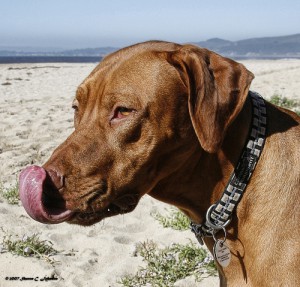Canine Raw Diets Pros and Cons

Traditionally, canned foods and kibble have been the staple food of our pet dogs, but this has been challenged in recent years by the growing popularity of the raw food diet. This type of diet is fairly controversial, with opinion increasingly polarised on either side of the debate.
If you're thinking of going down the raw feeding route with your pet or you're just curious as to why more pet owners are turning to this type of diet, you'll want to know more about precisely what it entails and whether or not it may right for your pet.
What Does Raw Feeding Involve?
Also known as the Bones and Raw Food (BARF) diet and the Biologically Appropriate Raw Food (BARF) diet, the bulk of the raw food diet includes raw meat or organ meat such as offal. This is usually supplemented with meaty bones and can also be bulked out with eggs, fruit, vegetables and some dairy such as yoghurt. Raw feeding advocates consider grain-based pet foods to be bad for canine health.
Pros of Raw Feeding
The argument of the pro raw feeding camp is the idea that it is healthier than a commercial diet involving canned food and kibble, largely because their canine ancestors ate a diet rich in raw meat and bones and this is believed to be the best option for their domesticated counterparts.
There isn't any concrete scientific evidence to say whether this is actually true at the moment but the basic argument behind the raw feeding diet is based on health. Raw feeders believe that the diet has benefits for their dog's health and wellbeing which a regular dog food diet does not offer.
Some of the potential benefits of raw feeding include:
- Knowing exactly what is in your dog's food, which isn't always the case with commercial pet foods. You can completely control what your dog eats.
- Helping to maintain a healthy weight, largely due to having fewer carbs than a lot of commercial pet food and no "filler" to bulk it out.
- Many pet owners who feed raw claim that it helps their dog to have more energy and a healthier, glossier coat but this is not scientifically proven to be the case.
Cons of Raw Feeding
Many dog owners aren't keen on the idea of raw feeding their pet as they fear that they could get ill from bacteria. There is a small risk of this but generally speaking, this isn't as big a problem as you may initially suspect. Dogs tend to have a far stronger constitution than humans and what would undoubtedly make us ill can often have little to no effect on dogs.
On a similar note, there is some risk involved in handling and preparing raw food for your dog. Bacteria found in raw meat can include e.coli and salmonella, and this can be present in your dog's faeces. This can be more problematic if there are people in the home with a compromised immune system. Most people won't have a problem if the usual hygiene rules are applied where raw meat is concerned.
You can minimise the risk of bacteria spread by using stainless steel bowls to serve their raw food, and by washing up their bowls as soon as your pet has finished eating so that bacteria doesn't get the chance to multiply.
Bones can be another big concern and many dog owners are worried that their dog will accidentally swallow bones (which can lead to intestinal blockages) or break their teeth when chewing them. Cooked bones should be avoided for these reasons but there is plenty of variety with meaty bones.
Other potential downsides to raw feeding include:
- Nutritional deficiencies can occur and may not show up for weeks or months after going on a raw food diet. This can be exaggerated by the fact that raw vegetables are often poorly digested compared to cooked vegetables, which is why many experts advocate juicing them so that your dog gets the best nutritional value from them. Some experts are concerned that a homemade raw diet can be lacking in minerals such as calcium and phosphorous.
- It can potentially be rather time consuming to make sure that a raw diet is balanced enough to provide all of the nutrients that your pet needs to stay healthy.
- Some pets have been known to experience diarrhoea and other digestive issues after switching to a raw diet but this won't affect all dogs.
Is It Right for Your Pet?
Many of the perceived benefits of raw feeding are not yet backed up by scientific evidence so it can be trial and error to decide whether it will work well for your pet. Not all pets will enjoy raw feeding and you may find that yours is one of them, even if you know other pets who have thrived on it.
If you really want to go down the raw feeding route but your pet doesn't seem all that keen on it, you may want to look at doing a bit of compromise whereby they are predominantly fed on a commercial diet and this is supplemented with a small amount of raw food. This way, your pet gets some of the benefits of raw feeding without it being their sole diet.
It's also worth bearing in mind that raw feeding tends to be high in protein, which isn't suitable for dogs with kidney or liver problems. If your dog has gastrointestinal issues that you're hoping will clear up on a raw food diet, experts often recommend that you start them off with a cooked, homemade diet before you make the full switch to raw feeding.
Photo credit [MyRidgebacks – Sharon C Johnson]
Canine Raw Diets Pros and Cons
Source: https://www.animeddirect.co.uk/advice/pros-cons-raw-feeding/
0 Response to "Canine Raw Diets Pros and Cons"
Post a Comment